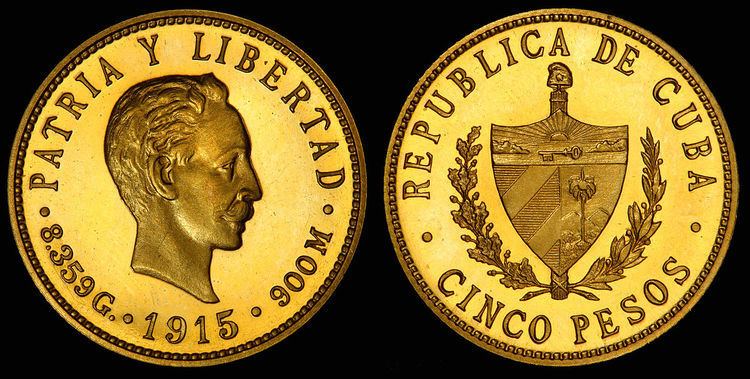Code CUP Symbol $, $MN, or ₱ Rarely used $1,000 | 1/100 centavo centavo ¢ or c | |
 | ||
Freq. used $1, $3, $5, $10, $20, $50, $100, $200, $500 | ||
The peso (ISO 4217 code: CUP, sometimes called the "national coin" or in Spanish moneda nacional) is one of two official currencies in use in Cuba, the other being the convertible peso (ISO 4217 code: CUC, occasionally called "dollar" in the spoken language). There are currently 25 CUP per CUC.
Contents
Most Cuban state workers receive their wages in national pesos, but some receive a portion of their salary in convertible pesos. Shops that sell basics like fruit and vegetables generally accept only the normal peso. "Dollar shops" sell the rest. The word "pesos" may refer to both types of money.
Cuban convertible pesos are 25 times more valuable, but that does not completely eliminate the confusion for tourists. Since goods bought in national pesos have government-controlled prices, tourists are sometimes confused by prices that look "too cheap." The hard (CUC) pesos are easy to tell apart from the national (CUP) ones, as CUC coins have an octagonal shape within the outer round rim. Also, CUC currency shows monuments, and CUP bills have portraits.
History
Before 1857, Spanish and Spanish colonial reales circulated in Cuba. From 1857, banknotes were issued specifically for use on Cuba. These were denominated in pesos, with each peso worth 8 reales. From 1869, notes were also issued denominated in centavos, with 100 centavos worth each peso. In 1881, the peso was pegged to the US dollar at par. The currency continued to be issued only in paper form until 1915, when the first coins were issued.
In 1960, the peg to the dollar was replaced by one to the Soviet ruble. The peso lost value by the United States embargo against Cuba and the suspension of the sugar quota. The suspension was the principal economic force driving Cuba to seek out a new economic partner, the Soviet Union. When the Soviet Union dissolved in 1991, the peso lost much of its value and the exchange rate fell to 125 pesos to the US dollar. Recently, it has become more valuable and fluctuated between 23 and 25 pesos to the US dollar.
In 1993, during the period of economic austerity known as the Special Period, the US dollar was made legal tender to encourage hard currency to enter the economy. The US dollar became the currency used to purchase some non-essential goods and services, such as cosmetics, and even staple kinds of food and drink. In 1994, the convertible peso was introduced at a par with the dollar. On November 8, 2004, the Cuban government withdrew the US dollar from circulation, citing the need to retaliate against further US sanctions.
Coins
In 1897 and 1898, pesos were issued by revolutionary forces promoting independence. In 1915, cupro-nickel 1, 2 and 5 centavos, silver 10, 20 and 40 centavos and 1 peso, and gold 1, 2, 4, 5, 10 and 20 peso coins were introduced. These coins were designed by Charles E. Barber, who also designed the Barber dimes, quarters, half dollars for the US. The coins were minted at the US mint at Philadelphia. The gold coins and 2 centavos were not produced after 1916, with the large star design 1 peso ceasing production in 1934. A new silver peso showing a woman, representing the Cuban Republic, beneath a star (the "ABC peso") was issued from 1934 to 1939. Finally, a centennial of Jose Marti commemorative peso (also minted in 50, 25, and 1 centavos denominations) was produced in 1953.
Brass 1 and 5 centavos were issued in 1943, and with copper nickel composition sporadically from 1915 to 1958. Beginning in 1915, 2, 5, 10, 20 and 40 centavos coins were occasionally minted. The last 10, 20, and 40 centavo coins were produced in 1952; these were commemorative issues celebrating the fiftieth year of the republic. As mentioned above, in 1953, silver 25 and 50 centavos commemorative coins were also issued. These were the last silver coins issued for circulation. The last US produced coin was the 1961 five centavo piece.
In 1962, cupro-nickel 20 and 40 centavos were introduced, followed, in 1963, by aluminium 1 and 5 centavos. In 1969, aluminium 20 centavos were introduced, followed by aluminium 2 centavos and brass 1 peso in 1983. Cupro-nickel 3 peso coins were introduced in 1990, with brass-plated-steel 1 peso and nickel-clad-steel 3 peso coins following in 1992. 40 centavo coins were withdrawn from circulation around July 2004 and are no longer accepted as payment. Coins currently in circulation are 1, 2, 5 and 20 centavos and 1 and 3 pesos.
Between 1988 and 1989, the National Institute of Tourism (Instituto Nacional de Turismo, "INTUR") issued "Visitors Coinage" for use by tourists. In 1981, cupro-nickel 5, 10, 25 and 50 centavos and 1 peso were introduced, followed in 1988 by aluminium 1, 5, 10, 25 and 50 centavos. The INTUR coins were demonetized on October 15, 2001 and were replaced by fractional convertible pesos in 1, 5, 10, 25, 50 centavos and 1 peso, minted in Canada. In late 2004, a 5 convertible peso coin, dated 1999, was placed into circulation.
CUP and CUC
Employees of the Cuban state and of state enterprises are paid their basic salary in CUP, with some paid a performance-dependent bonus in CUC. Staple goods and services not oriented towards foreigners are usually paid in CUP. 'Luxury' goods and services, including most imported goods and anything intended for consumption by foreigners, are generally paid for in CUC. From about 2014, many state shops are accepting either currency, with exchange charts posted by the tills.
As of November 25, 2016, the rate is 1:26.5 to exchange CUC for CUP.
